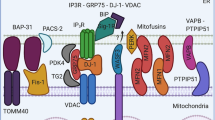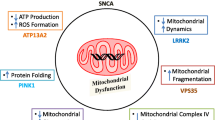Abstract
Many of the neurodegenerative diseases that afflict humans are characterised by the protein aggregation in neurons. These include complex diseases like Alzheimer’s disease and Parkinson’s disease, and Mendelian diseases caused by polyglutamine expansion mutations [like Huntington’s disease (HD) and various spinocerebellar ataxias (SCAs), like SCA3]. A range of functional genomic strategies have been used to try to elucidate pathways involved in these diseases. In this minireview, I focus on how modifier screens in organisms from yeast to mice may be of value in helping to elucidate pathogenic pathways.
Similar content being viewed by others
References
Bilen J, Bonini NM (2005) Drosophila as a model for human neurodegenerative disease. Annu Rev Genet 39:153–171
Branco J, Al-Ramahi I, Ukani L, Pérez AM, Fernandez-Funez P et al (2008) Comparative analysis of genetic modifiers in Drosophila points to common and distinct mechanisms of pathogenesis among polyglutamine diseases. Hum Mol Genet 17:376–390
Brown SD, Nolan PM (1998) Mouse mutagenesis—systematic studies of mammalian gene function. Hum Mol Genet 7:1627–1633
Cooper AA, Gitler AD, Cashikar A, Haynes CM, Hill KJ et al (2006) Alpha-synuclein blocks ER-Golgi traffic and Rab1 rescues neuron loss in Parkinson’s models. Science 313:324–328
Giorgini F, Guidetti P, Nguyen Q, Bennett SC, Muchowski PJ (2005) A genomic screen in yeast implicates kynurenine 3-monooxygenase as a therapeutic target for Huntington disease. Nat Genet 37:526–531
Hitotsumachi S, Carpenter DA, Russell WL (1985) Dose-repetition increases the mutagenic effectiveness of N-ethyl-N-nitrosourea in mouse spermatogonia. Proc Natl Acad Sci USA 82:6619–6621
Imarisio S, Carmichael J, Korolchuk V, Chen C-W, Saiki S et al (2008) Huntington’s disease—from pathology and genetics to potential therapies. Biochem J 412:191–209
Isaacs AM, Oliver PL, Jones EL, Jeans A, Potter A et al (2003) A mutation in Af4 is predicted to cause cerebellar ataxia and cataracts in the robotic mouse. J Neurosci 23:1631–1637
Jeans AF, Oliver PL, Johnson R, Capogna M, Vikman J et al (2007) A dominant mutation in Snap25 causes impaired vesicle trafficking, sensorimotor gating, and ataxia in the blind-drunk mouse. Proc Natl Acad Sci U S A 104:2431–2436
Justice MJ, Noveroske JK, Weber JS, Zheng B, Bradley A (1999) Mouse ENU mutagenesis. Hum Mol Genet 8:1955–1963
Kaltenbach LS, Romero E, Becklin RR, Chettier R, Bell R et al (2007) Huntingtin interacting proteins are genetic modifiers of neurodegeneration. PLoS Genet 3(5):e82
Kraemer BC, Burgess JK, Chen JH, Thomas JH, Schellenberg GD (2006) Molecular pathways that influence human tau-induced pathology in Caenorhabditis elegans. Hum Mol Genet 15:1483–1496
Nollen EA, Garcia SM, van Haaften G, Kim S, Chavez A et al (2004) Genome-wide RNA interference screen identifies previously undescribed regulators of polyglutamine aggregation. Proc Natl Acad Sci USA 101:6403–6408
Rosenblatt A, Brinkman RR, Liang KY, Almqvist EW, Margolis RL et al (2001) Familial influence on age of onset among siblings with Huntington disease. Am J Med Genet 105:399–403
Rubinsztein DC (2006) The roles of intracellular protein degradation pathways in neurodegeneration. Nature 443:780–786
Shedlovsky A, McDonald JD, Symula D, Dove WF (1993) Mouse models of human phenylketonuria. Genetics 134:1205–1210
Squitieri F, Sabbadini G, Mandich P, Gellera C, Di Maria E et al (2000) Family and molecular data for a fine analysis of age at onset in Huntington disease. Am J Med Genet 95:366–373
Telenius H, Kremer HPH, Thellmann J, Andrew SE, Almqvist E et al (1993) Molecular analysis of juvenile Huntington disease: the major influence on (CAG)n repeat length is the sex of the affected parent. Hum Mol Genet 10:1535–1540
Wexler NS, Lorimer J, Porter J, Gomez F, Moskowitz C et al (2004) Venezuelan kindreds reveal that genetic and environmental factors modulate Huntington’s disease age of onset. US-Venezuela Collaborative Research Project. Proc Natl Acad Sci USA 101:3498–3503
Acknowledgments
I am grateful to the MRC, the EU, and the Wellcome Trust (Senior Clinical Fellowship) for funding in areas related to this article.
Author information
Authors and Affiliations
Corresponding author
Rights and permissions
About this article
Cite this article
Rubinsztein, D.C. Functional genomics approaches to neurodegenerative diseases. Mamm Genome 19, 587–590 (2008). https://doi.org/10.1007/s00335-008-9130-0
Received:
Accepted:
Published:
Issue Date:
DOI: https://doi.org/10.1007/s00335-008-9130-0




